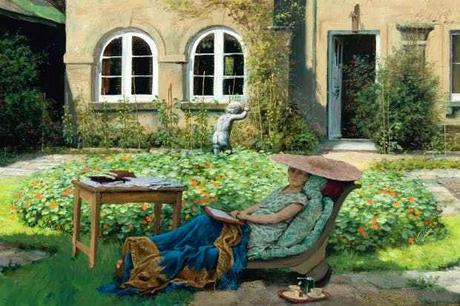
I’ve been having a marvelous time over the past couple of weeks slowly reading this delightful book a chapter per day before I go to bed. I have always been fascinated by stately homes, and particularly how they fared in the early years of the twentieth century, after and between the wars, with so many families struggling financially, servants hard to come by and a large number of heirs being killed while fighting. The National Trust came to the rescue of many stately homes that were at risk in these years, but many were dismantled, destroyed or left to become ruins, as another book I have been very much enjoying leafing through as a companion volume, England’s Lost Houses, details in heartbreaking photographs. However, The Long Weekend shows that the country house was certainly not dead after 1918; far from it. The chapters explore different aspects of the actual upwards trend in buying, renovating and building country houses in the interwar years, with author Adrian Tinniswood arguing that the wars caused an upswing in the purchasing of country estates, renovations of castles and crumbling Jacobean piles by enthusiastic antiquarians, and the building of large new homes in the countryside thanks to tumbling land prices and a swelling of patriotism and renewed interest in the traditions of rural life after the First World War.
The country house buyers, owners, inheritors and renovators of these interwar years fell into distinct camps. There were those who wanted country life but with all mod-cons, transforming old piles into sleek, modern party palaces complete with infinity pools and striking, racy interior décor, or building startling white and chrome Art Deco mansions to replace unfashionable, draughty Victorian piles that needed too much work doing to make them suitable for contemporary life. Then there were those, such as Lord Astor, with a romanticised view of the past, buying up tumble-down castles and Tudor and Jacobean mansions and restoring them brick-by-brick, taking delight in hunting for architectural salvage taken from the many houses being torn down during these years to recreate a historically authentic look. Most often, however, there were people looking for a slice of country life on a pared-down scale, building manageably sized bolt-holes that allowed them to be lord-of-the-manor without having to look after tenants and keep half their rooms draped in dust sheets. They went to architects like Lutyens, who built some marvelous smaller stately homes in the inter-war years, in a mixture of Arts and Crafts and Neo Georgian styles that suited the nostalgia of the time.
From how country homes were designed and decorated to how the people who lived in them travelled, partied and adapted their pre-war ways of life to the post-war world, The Long Weekend covers every area of perceivable interest, in lavishly illustrated detail. Of course, it wasn’t all glitz and glamour; for all those people who were doing up and living it up in the inter-war years, there were plenty who were just about hanging on, making do with freezing rooms, no electricity, mold running down the walls and having to sell a painting every few months to pay the bills. I always find it fascinating when I go to a National Trust or English Heritage property, to see how properties were modernised – or not – during the twentieth century, and it’s always the bathrooms of the unmodernised ones that fill me with horror. Invariably absinthe green, with water-stained, chipped cast iron baths, toilets that look like something out of a horror movie, and a damp chill oozing from the walls, I can’t imagine what it must have been like to get up on a cold January morning and have to get ready in one of them! As lovely as some of the places Adrian Tinniswood describes must have been, I remember reading in Jessica Mitford’s Hons and Rebels about how impossible it was to sleep in most stately homes at the time, with central heating being largely nonexistent, and bedrooms so cold you could see your breath. If you weren’t one of the stately home owners in the pre-war period with bags of cash, I can imagine life was actually rather miserable!
Advertisements